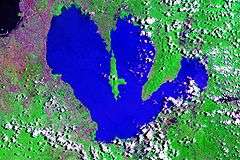San Cristobal River
| San Cristobal River | |
|---|---|
| Basin | |
| River mouth | 14°13′49.5″N 121°11′12.4″E / 14.230417°N 121.186778°ECoordinates: 14°13′49.5″N 121°11′12.4″E / 14.230417°N 121.186778°E |
| Mouth elevation | less than 2 meters above sea level |
| Country | Philippines |
The San Cristobal River (Tagalog: Ilog ng San Cristobal) is a river system in the cities of Calamba and Cabuyao, Laguna, Philippines. The river forms as Calamba's northern boundary with Cabuyao.[1][2] The river is one of 21 major tributaries of Laguna de Bay.
Hydrology
The main source of the San Cristobal River is Mount Sungay, the highest mountain of Cavite province, where the main stem and its tributaries drain the northern and eastern side of the mountain.[3] Its watershed area covers Calamba City and Cabuyao City in Laguna, Tagaytay City and the municipality of Silang in Cavite. The river system of San Cristobal from Mount Sungay, is connected to the Matang Tubig located in Canlubang. [4]
Water quality
Along with the San Juan River, the two rivers act as natural drainage systems by receiving and conveying Calamba's (and Cabuyao's for San Cristobal) liquid wastes and storm surface runoff to the nearby Laguna de Bay. Both rivers are very polluted as a result, thus, affecting the water quality of the lake as well.[1]
Although a 1991 study cited the San Pedro River and Morong River as the sources of eutrophication-causing minerals in Laguna de Bay, the Laguna Lake Development Authority (LLDA) has noted that more recent deterioration of the San Cristobal River in Calamba have made it one of the lake's major sources of nutrient loading.[5] The LLDA's conservation efforts for the major tributaries and watersheds of Laguna de Bay have led to the creation of the Laguna de Bay River Basin Councils, of which the San Cristobal River Enhancement Defenders (SACRED) is particularly tasked with conservation of the San Cristobal.[6]
See also
References
- 1 2 World Bank Environmental Assessment Report: Calamba, Laguna, August 1997, retrieved 2007-09-30
- ↑ REPUBLIC ACT NO. 9024: AN ACT CONVERTING THE MUNICIPALITY OF CALAMBA, PROVINCE OF LAGUNA INTO A COMPONENT CITY TO BE KNOWN AS THE CITY OF CALAMBA., 5 March 2001, retrieved 2007-09-30
- ↑ "Mount Sungay". Google Maps. Retrieved on 2014-09-19.
- ↑ Final List of Watersheds Supporting 140 River Irrigation System of the NIA (PDF), 2006, retrieved 2012-08-15
- ↑ The Laguna de Bay Masterplan, 1995, archived from the original (– Scholar search) on 2007-09-29, retrieved 2007-09-30
- ↑ Project to protect waterways: Assistance for the San Cristobal, 11 January 2007, retrieved 2007-09-30
| ||||||||||||||||||||||||||||||||||||||||||||||||
